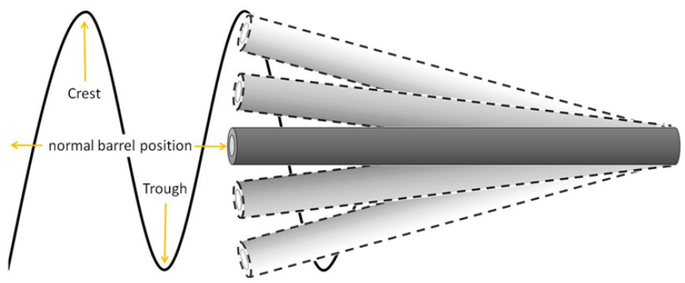Larry Gibson
posted this
30 November 2023
Wm Cook
I believe you are correct.
I also disagree with MP 1886 because he apparently believes;
" Vibration or sound waves too, travel in an up down wave."
Ergo, there in is the problem with the "sound wave" theory. It is a simple explanation and is usually graphed out two dimensionally for explanation purposes which is where the "up and down" representation comes from. However, Barrels do not vibrate "up and down" as in a linear two dimensional movement. Barrels vibrate in a three dimensional motion causing the muzzle to rotate in circular motion when can be somewhat irregular.
The definition of a "node", as discussed here, {"node" has several definitions but the used in barrel vibration, as in discussions of barrel vibrations, simply refers to a specific point in the movement. Look up the definition(s) in the dictionary. As used in sound wave discussion you have high nodes, low nodes and neutral nodes. You also have the movement IYou also have the movement between those nodes. Thus, with the muzzle end of a barrel vibrating in a three dimensional movement what we seek to do is to have the bullet exit at the same point of that movement (i.e. effect a "node" of that movement), The idea/theory behind having the ES as small as possible is that the bullets are exiting the muzzle at the same node position(?).
This could be perhaps why "working up a load" or "tuuning" the load to a specific rifle/barrel works as the develops a low ES so the bullets exit the muzzle at the same, or close to the same, node/location of the muzzle movement(?). The question to that is often, does the barrel muzzle move in an even circular motion or is it irregular(?). It may be that accurate barrels do vibrate in a consistent circular movement. We can tune the load or use a "tuner" to obtain consistent bullet exit at the same node/point of the vibration movement. the theory further assumes "stressed" barrel muzzles vibrate in irregular motion, thus it is difficult to get the bullets, even with a low ES load, to exit at or near the same node/point. The use of tuners, barrel weights and suppressors often dampen those vibrations whereby accuracy/precision is improved.
It is proven a consistently accurate load [not ones that are found with one "group" at a specific range] will have a relatively low ES with an SD proportional to the ES. That is not saying it will have the lowest ES or particularly, the lowest SD but will be in the low range for the cartridge and components. That is demonstrated many times in the 308W with the faster burning powders giving more uniform ballistics (the ES/SDs) that slower burning powders. Yet the faster burning powders may not give the performance needed at other ranges or "fall apart" as the range increases. There are many variables there that can affect both types of loads. However, if just shooting at 100 and 200 yards as in CBA matches then the faster burning powders such as 2400 vs 4895 can come into their own. I always continue to search for precision loads that also have a low, for the cartridge, ES with the proportional SD. Those have consistently proven to be the better, more accurate loads.
All techniques used to lower the ES/SDs, including drilling the flash holes larger, are beneficial to this endeavor.
LMG
Concealment is not cover.........











